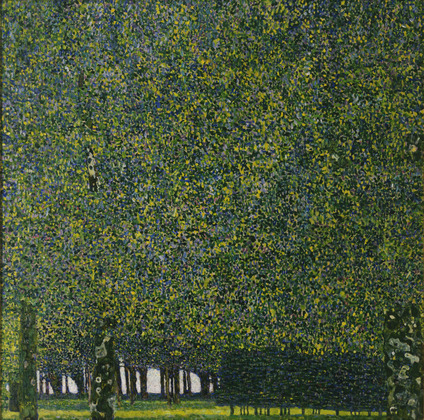The Park
Gustav Klimt incorporates an signature style of pointillism and impressionism as he depicts a peaceful setting showcased within the artwork, The Park.
While most of the canvas is covered in a mosaic of colour as the leaves over power the rest of the canvas, the artist showcases a small portion of the painting where the foundation of the lush canopy begins. Gustav Klimt had most often altered his work between Realism, Art Nouveau portraits and mosaic golds; however the artist had always returned to his peaceful impressionist landscapes.
Klimt had spent an immense number of summers in the countryside on Lake Attersee, a deep azure lake surrounded by small villages. Within his time in the countryside, the artist had transitioned his work to beautiful horizontal landscape portraits that captured the natural scenery and colours of the land. These pieces always carried a pleasant emotion behind the work as they were filled with colour and life. Gustav Klimt had used an Art Nouveau style to depict these setting, with a sponge technique. Similar works to The Park include: Apple Tree I, Farmhouse in Upper Austria, and Garden Path With Hens. All of these paintings analyze the dot technique Klimt used to add structure and shapes to his work, while still depicting the scene.
While most of the canvas is covered in the leaves of the tree, the bottom part simply illustrates the landscape. The grass is covered in a light salad colour, where tree trucks are rooted. While overall the painting holds a flat landscape, the bottom glimpse of land elongates the piece briefly. The viewer is able to look ahead and witness the countryside that unfolds, with a glimpse of white that is meant to showcase the sky.
The focal point of the canvas remains to be the lush canopy that mixes in together. The tree has a similar style to the many pear trees Klimt had painted throughout his career. The colour scheme is based on shades of green that range from light to dark, and a lavender blue. Overall there are three primary colours in the canopy. Light green to highlight, dark green to shade and blue to accentuate.
The way in which the artist paints the leaves is a critical element to understand to feel his work. The artist used his brush in a swift motion, hitting it against the canvas in light brush strokes. Depending on the feel of the work, the artist uses his brush in a cluster of directions and pressures to achieve the desired effect. Within The Park, Klimt had painted with his brush moving upwards, in a vertical direction to achieve the dot effect.
The spongy feel of the work adds to the impressionist style Klimt focused his landscape portraits on. While the location of the scene does not resemble a park as referred to in the title, the large clusters of trees together is a common theme scene throughout the artist's work.
Gustav Klimt will go on to paint an array of paints, most potently in his Gold Phase. These painting include Tannenwald, Three Ages of Woman, Danae, and Hope II. These classic art pieces interpret the artist's fascination for mosaic styles and patterns, a trademark signature within his work. While the artist is prominently known for these, the emotion and feel that is portrayed through the artist's impressionist work does not carry the same significant.
It was unpopular at the time to depict the impressionism landscape, especially for Klimt who received his fame based on his golden technique. However, the artist continued to run away each summer to the countryside in the deep Lake Attersee to showcase the beautiful scenery around him to the world. It was this style that seized his out of all, and brought joy to his life unlike any other.




